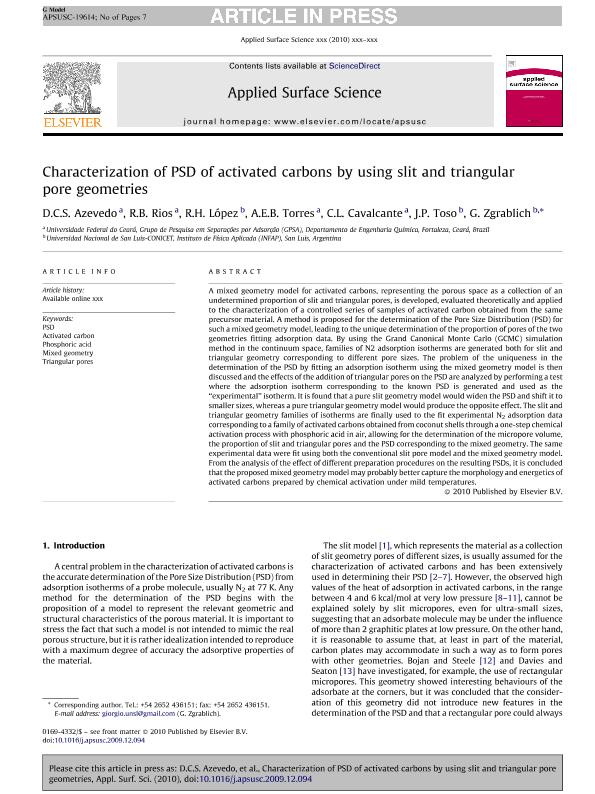Mostrar el registro sencillo del ítem
dc.contributor.author
Azevedo, D. C. S.
dc.contributor.author
Rios, R. B.
dc.contributor.author
López, Raúl Horacio

dc.contributor.author
Torres, A. E. B.
dc.contributor.author
Cavalcante, C. L.
dc.contributor.author
Toso, J. P.
dc.contributor.author
Zgrablich, Jorge Andres

dc.date.available
2017-03-20T18:36:45Z
dc.date.issued
2010-06
dc.identifier.citation
Azevedo, D. C. S.; Rios, R. B.; López, Raúl Horacio; Torres, A. E. B.; Cavalcante, C. L.; et al.; Characterization of PSD of activated carbons by using slit and triangular pore geometries; Elsevier Science; Applied Surface Science; 256; 17; 6-2010; 5191-5197
dc.identifier.issn
0169-4332
dc.identifier.uri
http://hdl.handle.net/11336/14106
dc.description.abstract
A mixed geometry model for activated carbons, representing the porous space as a collection of an undetermined proportion of slit and triangular pores, is developed, evaluated theoretically and applied to the characterization of a controlled series of samples of activated carbon obtained from the same precursor material. A method is proposed for the determination of the Pore Size Distribution (PSD) for such a mixed geometry model, leading to the unique determination of the proportion of pores of the two geometries fitting adsorption data. By using the Grand Canonical Monte Carlo (GCMC) simulation method in the continuum space, families of N2 adsorption isotherms are generated both for slit and triangular geometry corresponding to different pore sizes. The problem of the uniqueness in the determination of the PSD by fitting an adsorption isotherm using the mixed geometry model is then discussed and the effects of the addition of triangular pores on the PSD are analyzed by performing a test where the adsorption isotherm corresponding to the known PSD is generated and used as the “experimental” isotherm. It is found that a pure slit geometry model would widen the PSD and shift it to smaller sizes, whereas a pure triangular geometry model would produce the opposite effect. The slit and triangular geometry families of isotherms are finally used to the fit experimental N2 adsorption data corresponding to a family of activated carbons obtained from coconut shells through a one-step chemical activation process with phosphoric acid in air, allowing for the determination of the micropore volume, the proportion of slit and triangular pores and the PSD corresponding to the mixed geometry. The same experimental data were fit using both the conventional slit pore model and the mixed geometry model. From the analysis of the effect of different preparation procedures on the resulting PSDs, it is concluded that the proposed mixed geometry model may probably better capture the morphology and energetics of activated carbons prepared by chemical activation under mild temperatures.
dc.format
application/pdf
dc.language.iso
eng
dc.publisher
Elsevier Science

dc.rights
info:eu-repo/semantics/openAccess
dc.rights.uri
https://creativecommons.org/licenses/by-nc-nd/2.5/ar/
dc.subject
Psd
dc.subject
Activated Carbon
dc.subject
Phosphoric Acid
dc.subject
Mixed Geometry
dc.subject.classification
Físico-Química, Ciencia de los Polímeros, Electroquímica

dc.subject.classification
Ciencias Químicas

dc.subject.classification
CIENCIAS NATURALES Y EXACTAS

dc.title
Characterization of PSD of activated carbons by using slit and triangular pore geometries
dc.type
info:eu-repo/semantics/article
dc.type
info:ar-repo/semantics/artículo
dc.type
info:eu-repo/semantics/publishedVersion
dc.date.updated
2017-03-20T14:10:56Z
dc.journal.volume
256
dc.journal.number
17
dc.journal.pagination
5191-5197
dc.journal.pais
Países Bajos

dc.journal.ciudad
Amsterdam
dc.description.fil
Fil: Azevedo, D. C. S.. Universidade Federal do Ceará; Brasil
dc.description.fil
Fil: Rios, R. B.. Universidade Federal do Ceará; Brasil
dc.description.fil
Fil: López, Raúl Horacio. Consejo Nacional de Investigaciones Científicas y Técnicas. Centro Científico Tecnológico San Luis. Instituto de Física Aplicada; Argentina. Universidad Nacional de San Luis; Argentina
dc.description.fil
Fil: Torres, A. E. B.. Universidade Federal do Ceará; Brasil
dc.description.fil
Fil: Cavalcante, C. L.. Universidade Federal do Ceará; Brasil
dc.description.fil
Fil: Toso, J. P.. Consejo Nacional de Investigaciones Científicas y Técnicas. Centro Científico Tecnológico San Luis. Instituto de Física Aplicada; Argentina. Universidad Nacional de San Luis; Argentina
dc.description.fil
Fil: Zgrablich, Jorge Andres. Consejo Nacional de Investigaciones Científicas y Técnicas. Centro Científico Tecnológico San Luis. Instituto de Física Aplicada; Argentina. Universidad Nacional de San Luis; Argentina
dc.journal.title
Applied Surface Science

dc.relation.alternativeid
info:eu-repo/semantics/altIdentifier/url/http://www.sciencedirect.com/science/article/pii/S0169433209018169
dc.relation.alternativeid
info:eu-repo/semantics/altIdentifier/doi/http://dx.doi.org/10.1016/j.apsusc.2009.12.094
Archivos asociados
